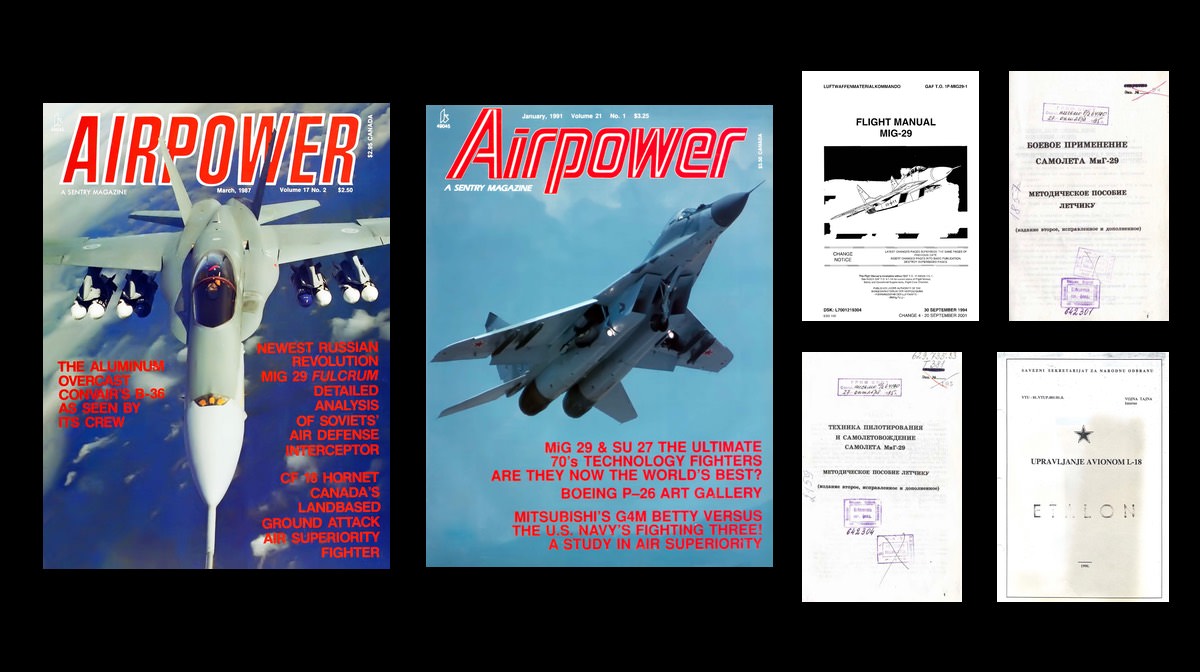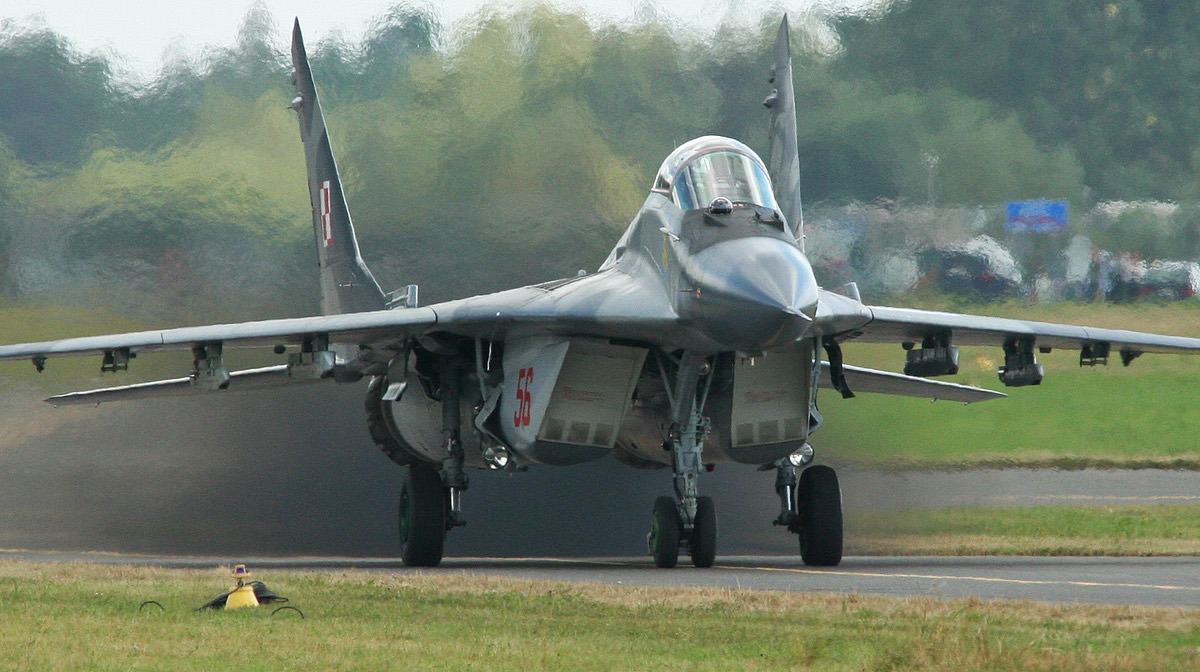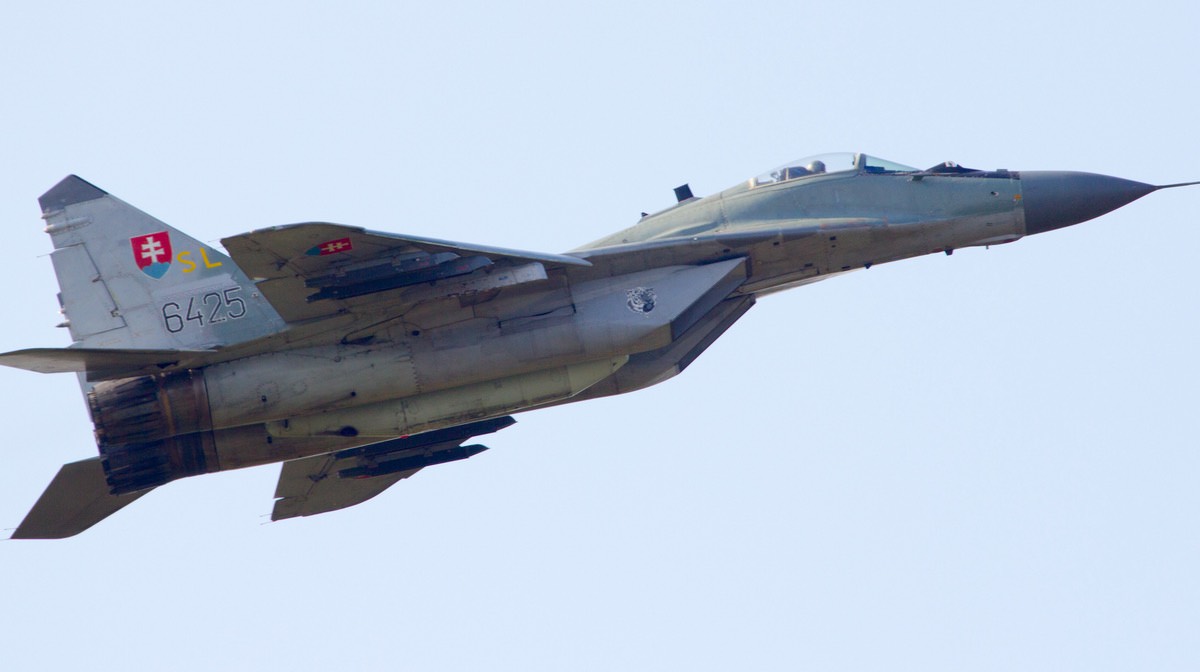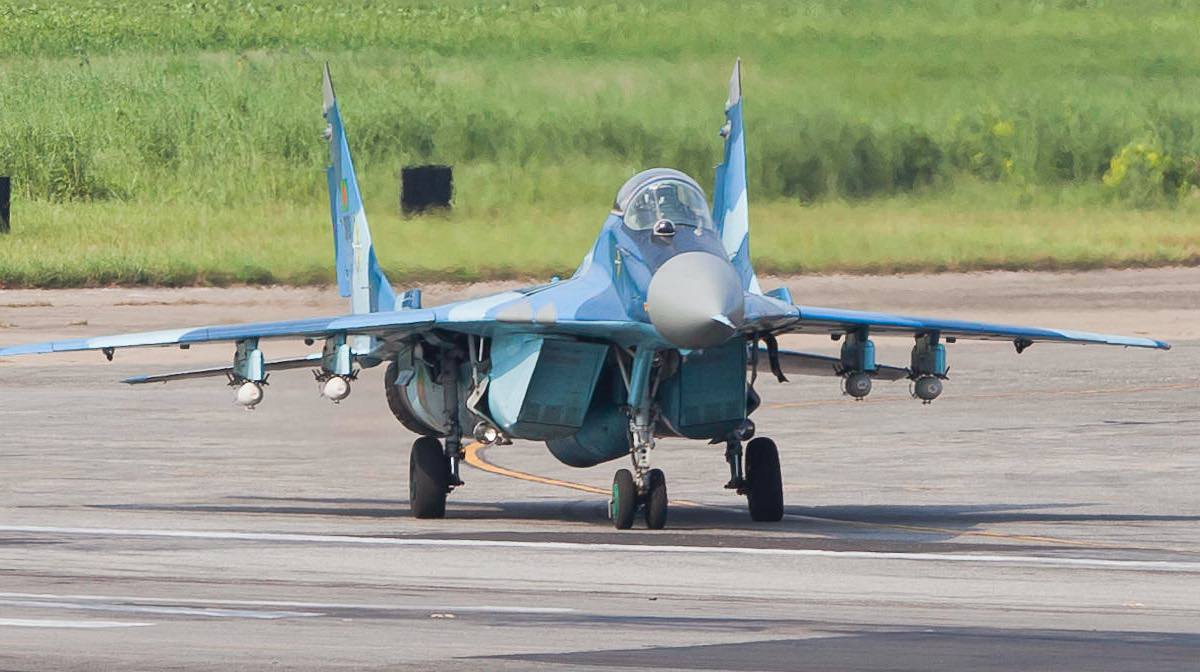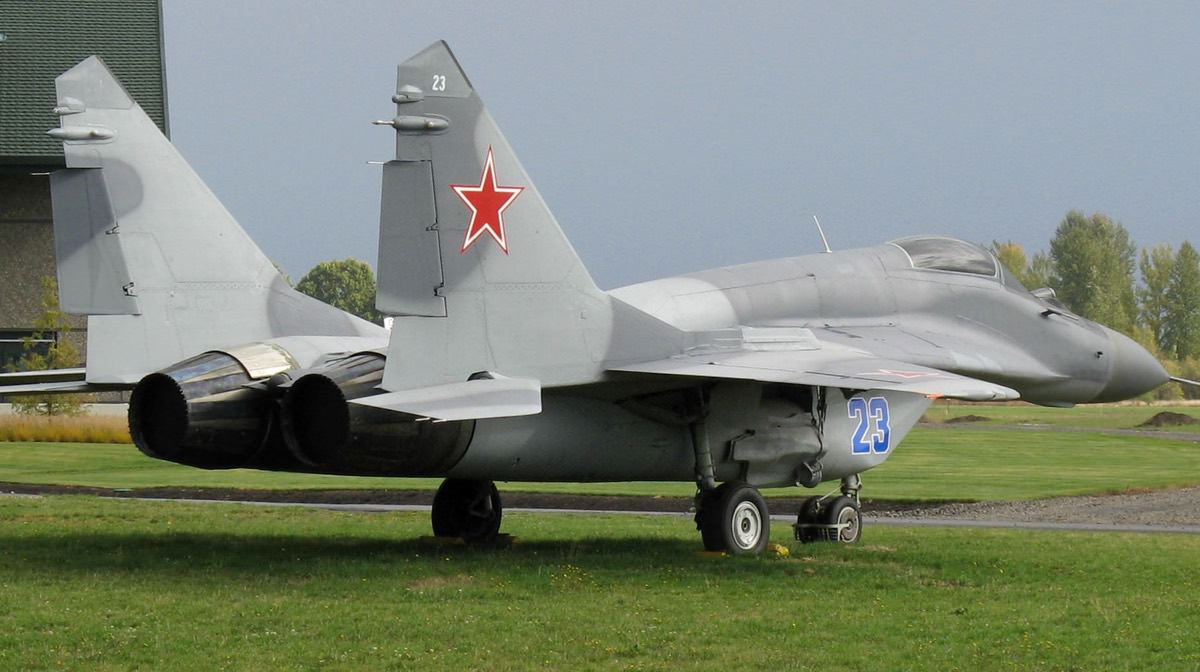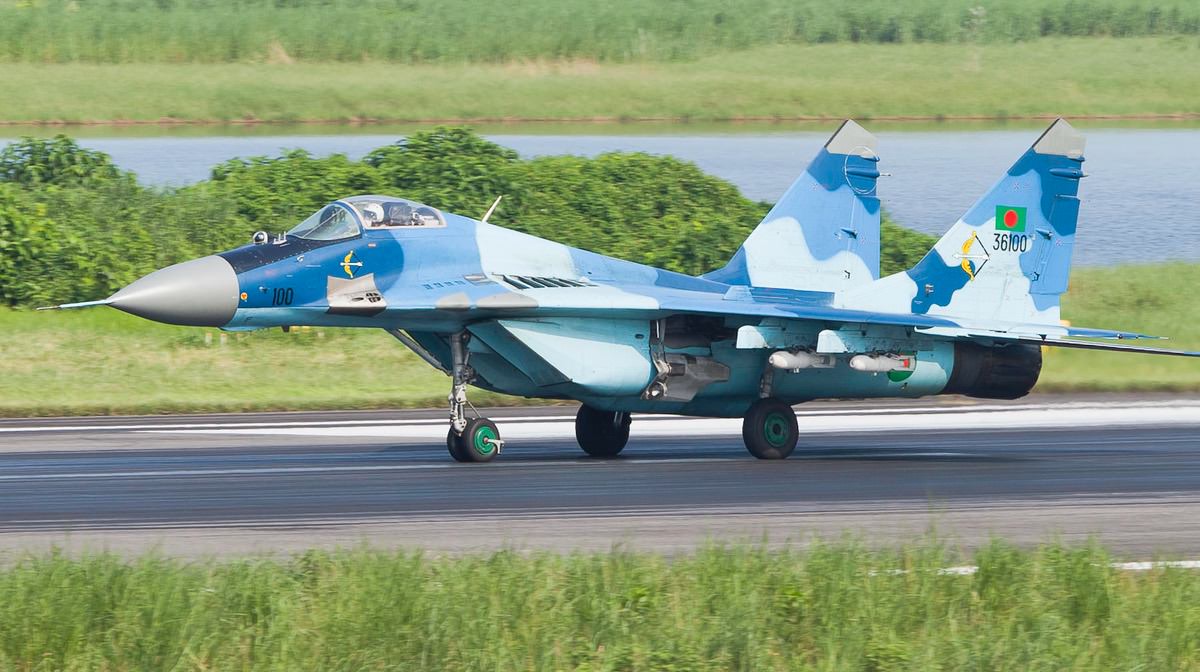Price: $14.95
- 2 magazines, 4 manuals, & photos
- PDF contains 1,238 pages
- Content is keyword searchable
- Print a personal copy
- Pay via PayPal or Credit Card
- International orders welcome!
- Download files upon payment
March 1987
- Convair’s B-36 “Aluminum Overcast”
- MiG-29 Fulcrum
- Canadian CF-18 Hornet
January 1991
- MiG-29 & Su-27, The Ultimate 70’s Technology Fighters
- Mitsubishi’s G4M Betty vs. the U.S. Navy’s Fighting Three
Manuals & Photos
- MiG-29 Flight-Manual, 2001
- MiG-29 Pilot Manual (Russian)
- MiG-29 Combat Use (Russian)
- MiG-29 Aircraft Maintenance (Polish)
- Over 120 photos of the Mikoyan MiG-29 Fulcrum
Mikoyan MiG-29 Fulcrum
Specifications
Variants
On Display
Cutaway
Videos
General Characteristics
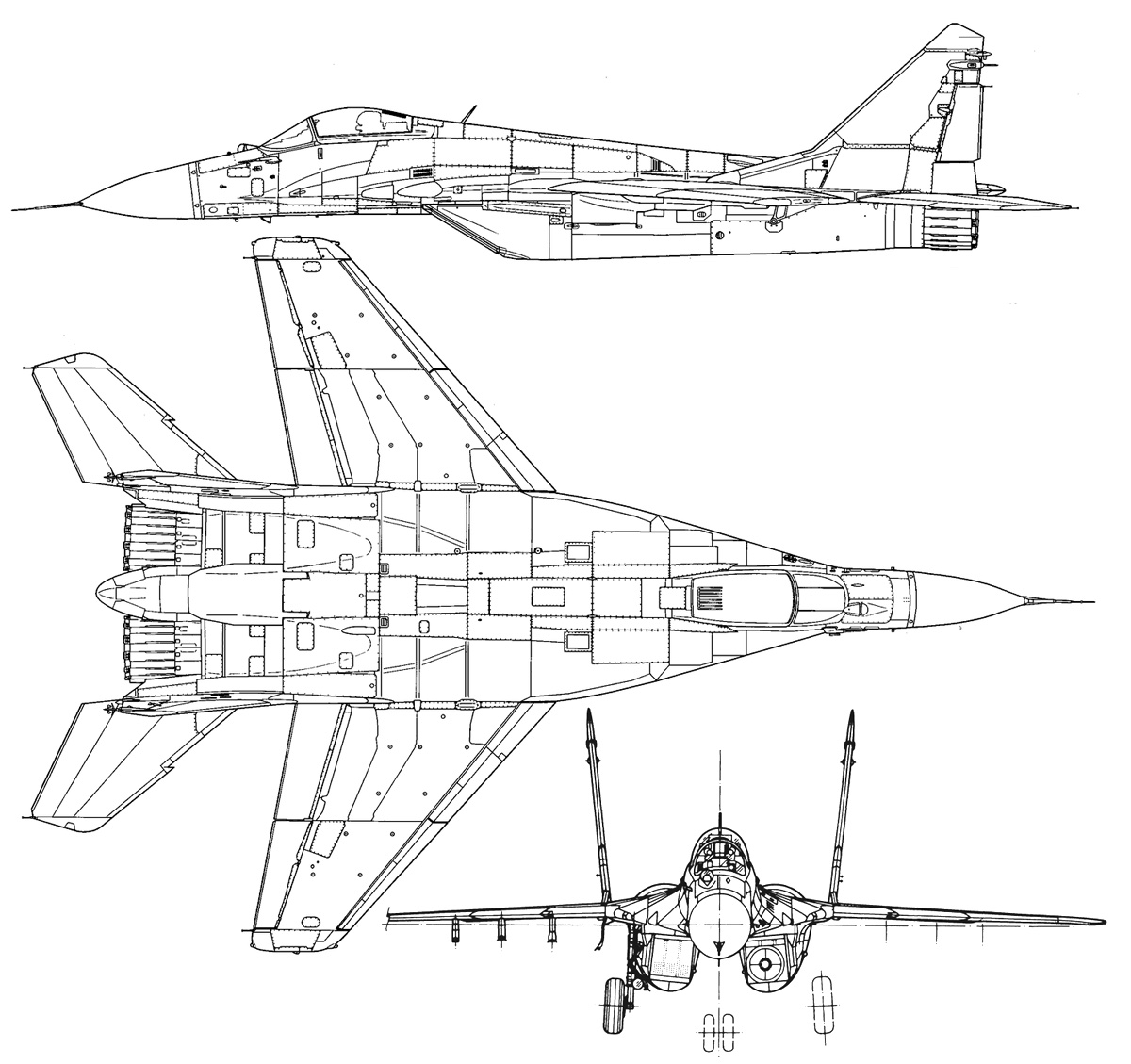
- Crew: 1
- Length: 17.32 m (56 ft 10 in)
- Wingspan: 11.36 m (37 ft 3 in)
- Height: 4.73 m (15 ft 6 in)
- Wing area: 38 m2 (410 sq ft)
- Empty weight: 11,000 kg (24,251 lb)
- Gross weight: 14,900 kg (32,849 lb)
- Max takeoff weight: 18,000 kg (39,683 lb)
- Fuel capacity: 3,500 kg (7,716 lb) internal
- Powerplant: 2 × Klimov RD-33 afterburning turbofan engines, 49.42 kN (11,110 lbf) thrust each dry, 81.58 kN (18,340 lbf) with afterburner
Performance
- Maximum speed: 2,450 km/h (1,520 mph, 1,320 kn) at high altitude
- Maximum speed: Mach 2.3+
- Range: 1,430 km (890 mi, 770 nmi) with maximum internal fuel
- Combat range: 700–900 km (430–560 mi, 380–490 nmi) with 2 x R-27s, 4 x R-73s at high altitude
- Ferry range: 2,100 km (1,300 mi, 1,100 nmi) with 1× drop tank
- Service ceiling: 18,000 m (59,000 ft)
- g limits: +9
- Rate of climb: 330 m/s (65,000 ft/min)
- Wing loading: 403 kg/m2 (83 lb/sq ft)
- Thrust/weight: 1.09
Armament
- Guns: 1 × 30 mm Gryazev-Shipunov GSh-30-1 autocannon. Originally held 150 rounds, reduced to 100 on later variants.
- Hardpoints: 7 × hardpoints (6 × underwing, 1 × fuselage) with a capacity of up to 4,000 kg (8,800 lb) of stores, with provisions to carry combinations of:
- Rockets:
- S-5
- S-8
- S-24
- Missiles:
- 2-4 × R-27R/ER/T/ET/P/EP air-to-air missiles
- 6 × R-60/R-60M AAMs
- 6 × R-73 AAMs (later variants also carry the R-73M, R-74 and R-74M)
- 4 × Astra (Indian Air Force)
- Rampage (Indian Air Force)
- AGM-88 HARM (Integration by Ukrainian Air Force during the 2022 Russian invasion of Ukraine)
- 2 × Kh-29T/ET (MiG-29SMT, MiG-29M/M2, MiG-29K/KR and MiG-35 only)
- 6 × R-77 (MiG-29S, MiG-29M/M2 & MiG-29K only)
- Bombs:
- 6 × 665 kg (1,466 lb) bombs
- 4 × FAB-500-M62 500kg general purpose bomb
- 4 × FAB-250-M62 250kg general purpose bomb
- 4 × BETAB-500 500kg concrete piercing bomb
- 4 × KMGU-AO2/PTAB munitions dispenser
- 4 × RBK-500-PTAB/255-PTAB 500kg cluster bomb
- 4 × RBK-250-PTAB/275-AO 250kg cluster bomb
- Other:
- 1 × 1400 L external drop tank
- 2 × 1100 L external drop tank
- Rockets:
Avionics
- Radar depands in variants: N019 family radar or Phazotron Zhuk-M (export designation Zhuk-ME) radar
- OEPS-29 IRST
- SPO-15 ‘Beryoza’ RWR
- DARE D-29 EW system (on MiG-29 UPG)
Original Soviet Variants
- MiG-29 (Product 9.12)
Initial production version for Soviet Air Force; entered service in 1983. NATO reporting name is “Fulcrum-A”. Variant possessed the Phazotron N019 Rubin radar, OEPS-29 optical-electronic sighting system and helmet mounted sight.
- MiG-29 (Product 9.12A) ‘Fulcrum-A’
Export variant of the 9.12 for Warsaw Pact pact countries which included a downgraded RPLK-29E radar, downgraded OEPrNK-29E optoelectronic and navigation systems and older IFF transponders. This variant also lacked the capability to deliver nuclear weapons. Delivered to East Germany, Czechoslovakia, Poland and Romania.
- MiG-29 (Product 9.12B) ‘Fulcrum-A’
MiG-29 variant of the 9.12 for non-Warsaw Pact pact countries which included a further downgraded radar and avionics. Delivered to India, Iraq, Syria, North Korea, Cuba, Malaysia, Myanmar and Eritrea.
- MiG-29UB (Product 9.51)
Twin seat training model. Infrared sensor mounted only, no radar. NATO reporting name is “Fulcrum-B”.
- MiG-29 (Product 9.13) ‘Fulcrum-C’
Update of the initial production version; entered service in 1986. NATO reporting name is “Fulcrum-C”. Variant possessed an enlarged dorsal spine to accommodate a larger No.1 fuel tank and the installation of the L-203BE Gardenyia-1 jammer that was lacking on the initial 9.12 version. This enlarged spine earned the 9.13 version and its successors the nickname of “Fatback”.
- MiG-29 (Product 9.13B) ‘Fulcrum-C’
Export variant of the 9.13 provided to North Korea in semi-knocked down (SKD) kits and built in Panghyon between 1991 and 1992. Like the 9.13, it has the Gardenyia-1 jammer but has downgraded avionics and no IFF. Other sources say the Gardenyia was not delivered to North Korea.
- MiG-29S (Product 9.13S)
The MiG-29S was an update of the original 9.13 model retaining the NATO reporting code “Fulcrum-C” and featured flight control system improvements; a total of four new computers provided better stability augmentation and controllability with an increase of 2° in angle of attack (AoA). An improved mechanical-hydraulic flight control system allowed for greater control surface deflections. The MiG-29S can carry 1,150 L (250 imp gal; 300 U.S. gal) under wing drop tanks and a centerline tank. The inboard underwing hardpoints allow a tandem pylon arrangement for carrying a larger payload of 4,000 kg (8,800 lb). Overall maximum gross weight was raised to 20,000 kg (44,000 lb). This version also included new avionics and the new Phazotron N019M radar and Built-In Test Equipment (BITE) to reduce dependence on ground support equipment. Development of this version was initiated due to multiple systems being compromised to the West by Phazotron engineer Adolf Tolkachev. This was the final version of the MiG-29 produced before the collapse of the Soviet Union and only limited numbers were produced.
Upgraded variants based on original airframe
- MiG-29S (Product 9.12S)
Post Soviet upgrade for older 9.12 variants incorporating the changes developed for version 9.13S.
- MiG-29SD (Product 9.12SD)
Export variant of upgraded 9.12S with downgraded versions of radar and avionics.
- MiG-29SE (Product 9.13SE)
Export variant of the 9.13S with slightly downgraded N-019ME radar with multiple target tracking ability and RVV-AE (R-77 missile) compatibility. The first export model MiG-29 with underwing drop tanks; the inner underwing pylons can carry over 500 kg (1,100 lb) bombs in side by side tandem pairs. Its weapons mix includes R-27T1, R-27ER1 and R-27ET1 medium-range missiles. The aircraft can be fitted with active ECM systems, weapons guidance aids, improved built-in check and training systems. The MiG-29SE can simultaneously engage two air targets.
- MiG-29SM (Product 9.13M)
Similar to the 9.13, but with the ability to carry guided air-to-surface missiles and TV- and laser-guided bombs. NATO reporting code is “Fulcrum-C”.
- MiG-29SM (SyAF)
For the Syrian Air Force, and based on the MiG-29SM, except the Syrian MiG-29SM uses the 9.12 airframe. RAC MiG developed a special variant for Syria.
- MiG-29G/MiG-29GT
East German MiG-29 / 29UB upgraded to NATO standards, with work done by MiG Aircraft Product Support GmbH (MAPS), a joint venture company form between MiG Moscow Aviation Production Association and DaimlerChrysler Aerospace in 1993.
- MiG-29AS/MiG-29UBS
Slovak Air Force performed an upgrade on their MiG-29/-29UB for NATO compatibility. Work is done by RAC MiG and Western firms, starting from 2005. The aircraft now has navigation and communications systems from Rockwell Collins, an IFF system from BAE Systems, new glass cockpit features multi-function LC displays and digital processors and also fitted to be integrate with Western equipment in the future. However, the armaments of the aircraft remain unchanged. 12 out of 21 of the entire MiG-29 fleet were upgraded and had been delivered as of late February 2008.
- MiG-29 Sniper
Upgrade planned for the Romanian Air Force by DASA, Aerostar and Elbit. DASA was responsible for program management, technical support and the test flight program (together with Elbit), Elbit was responsible for developing the avionics package, while Aerostar implemented the upgrades on the aircraft. The first flight occurred on 5 May 2000. The upgrades included the installation of a new modular multirole computer based on the MIL-STD-1553B data bus, upgraded Western avionics, new radio stations, hybrid navigation system composed of an inertial navigation system and coupled with GPS receiver, identification system, two 152 mm × 203 mm (6.0 in × 8.0 in) MFCDs, a Head-Up Display equipped with UFCP front control panel, new RWR, new HOTAS and new ADC. The addition of a new radar and the integration of Western weapons while maintaining Russian ones were also expected. The
- MiG-29SMT (Product 9.17)
The MiG-29SMT is an upgrade of first-generation MiG-29s (9.12 to 9.13) using enhancements on the MiG-29M. Additional fuel tanks in a further enlarged spine provide a maximum internal flight range of 2,100 km (1,300 mi). The cockpit has an enhanced HOTAS design, two 152 mm × 203 mm (6.0 in × 8.0 in) colour liquid crystal MFDs and two smaller monochrome LCDs. The MiG-29A lacked an advanced air-to-ground capability, thus the SMT upgrade adds the upgraded Zhuk-ME radar with air-to-ground radar detection and integrates air-to-ground guided weapons. It also has upgraded RD-33 ser.3 engines with afterburning thrust rated at 81 kN (18,000 lbf) each. The weapons load was increased to 4,500 kg (9,900 lb) on six underwing and one ventral hardpoints, with similar weapon choices to the MiG-29M. It can also accommodate non-Russian origin avionics and weapons.
- MiG-29BM
The MiG-29BM (probably Belarusian Modernised, possibly Bolyshaya Modernizaciya – large modernization) is an upgrade conducted by the ARZ-558 aircraft repair plant in Baranovichi, Belarus. It is a strike variant of the MiG-29 and the Belarusian counterpart to the Russian MiG-29SMT. It includes improvements to weapons, radar, as well as adding non-retractable air-air refueling ability. They entered service in 2003 and it is estimated, that ten or so were modernized to BM standard. The Bangladesh Air Force upgraded its MiG-29s similar to BM standard.
- MiG-29UBT (Product 9.51T)
SMT standard upgrade for the MiG-29UB. Namely users, Algeria and Yemen.
- MiG-29UPG
The UPG was a new modification intended for the MiG-29s used by the Indian Air Force. The Indian UPG version is similar to the SMT variant but differs by having a foreign-made avionics suite integrated within it. The weapons suite is the same as the SMT and K/KUB versions. It made its maiden flight on 4 February 2011. The version includes the new Zhuk-M radar, new avionics, an IFR probe, as well as new enhanced RD-33 Series 3 turbofan engines, and the DRDO/DARE D-29 Electronic Warfare System. The modernization is part of a $900 million contract to upgrade the 69 fighter fleet.
- MiG-29SMP / MiG-29UBP
The SMP/UBP are upgrades for the Peruvian Air Force MiG-29 fleet. In August 2008 a contract of US$106 million was signed with RAC MiG for this custom SM upgrade of an initial batch of eight MiG-29, with a provision for upgrading all of Peru’s MiG-29s. The single-seat version is designated SMP, whereas the twin-seat version is designated UBP. It features an improved ECM suite, avionics, sensors, pilot interface, and a MIL-STD-1553 databus. The interfaces include improved IRST capabilities for enhanced passive detection and tracking as well as better off-boresight launch capabilities, one MFCD and HOTAS. The N019M1 radar, a heavily modified and upgraded digital version of the N019 radar, replaces the standard N010 Zhuk-M of the MiG-29SMT. The upgrade also includes a structural life-extension program (SLEP), overhauled and upgraded engines, and the addition of an in-flight refuelling probe.
- MiG-29MU1
A Ukrainian modernization of the MiG-29.
- MiG-29MU2
A further Ukrainian modernization of the MiG-29, focused on air to ground munitions.
Second-generation variants with modified airframe
- MiG-29M / MiG-33 (Product 9.15)
Advanced multirole variant, with a redesigned airframe, mechanical flight controls replaced by a fly-by-wire system and powered by enhanced RD-33 ser.3M engines. NATO reporting code is “Fulcrum-E”.
- MiG-29UBM (Product 9.61)
Two-seat training variant of the MiG-29M. Never built. Effectively continued under the designation ‘MiG-29M2’.
- MiG-29M2 / MiG-29MRCA
Two-seat version of MiG-29M. Identical characteristics to MiG-29M, with a slightly reduced ferry range of 1,800 km (1,100 mi). RAC MiG presented in various air shows, including Fifth China International Aviation and Aerospace Exhibition (CIAAE 2004), Aero India 2005, MAKS 2005. It was once given designation MiG-29MRCA for marketing purpose and now evolved into the current MiG-35.
- MiG-29OVT
The aircraft is one of the six pre-built MiG-29Ms before 1991, later received thrust vectoringengine and fly-by-wire technology. It served as a thrust-vectoring engine testbed and technology demonstrator in various air shows to show future improvement in the MiG-29M. It has identical avionics to the MiG-29M. The only difference in the cockpit layout is an additional switch to turn on vector thrust function. The two RD-133 thrust-vectoring engines, each features unique 3D rotating nozzles which can provide thrust vector deflection in all directions. However, despite its thrust-vectoring, other specifications were not officially emphasized. It is usually used as an aerobatic demonstrator and has been demonstrated along with the MiG-29M2 in various air shows around the world for potential export.
- MiG-29K (Product 9.31)
Naval variant based on MiG-29M, the letter “K” stands for “Korabelnogo bazirovaniya” (deck-based). It features folding wings, arrestor gear, and reinforced landing gear. Originally intended for the Admiral Kuznetsov class aircraft carriers, it had received series production approval from the Russian Ministry of Defence but was grounded in 1992 due to shift in military doctrine and financial difficulties. The MiG Corporation restarted the program in 1999. On 20 January 2004, the Indian Navy signed a contract of 12 single-seat MiG-29K and four two-seat MiG-29KUB. Modifications were made for the Indian Navy requirement. Production MiG-29K and MiG-29KUB share a two-seater size canopy. The MiG-29K has radar absorbing coatings to reduce radar signature. Cockpit displays consist of wide HUD and three (seven on MiG-29KUB) colour LCD MFDs with a Topsight E helmet-mounted targeting system. It has a full range of weapons compatible with the MiG-29M and MiG-29SMT. NATO reporting code is “Fulcrum-D”.
- MiG-29KUB (Product 9.47)
Identical characteristic to the MiG-29K but with tandem twin seat configuration. The design is to serve as trainer for MiG-29K pilot and is full combat capable. The first MiG-29KUB developed for the Indian Navy made its maiden flight at the Russian Zhukovsky aircraft test centre on 22 January 2007. NATO reporting code is “Fulcrum-D”.
Czech Republic
- On display at the Prague Aviation Museum in Prague.
Germany
- 29+03 – MiG-29G on display at the Luftwaffenmuseum der Bundeswehr in Berlin. This airframe is the only remaining German MiG-29 in Germany. It was previously on display in Laage before being moved to the Luftwaffenmuseum der Bundeswehr in 2006 as part of the exhibition “50 Jahre Luftwaffe”.
Hungary
- One MiG-29 is on display with other older MiG planes and helicopters at The RepTár Museum of Szolnok, Hungary.
India
- KB-732 – On display as a gate guardian at Ojhar Air Force Station in Nasik, Maharashtra.
- KB-741 – On display at the Technical Type Training (TETTRA) School in Pune, Maharashtra.
Latvia
- 9-52 – MiG-29UB on display at the Riga Aviation Museum in Riga. This airframe is the second MiG-29UB prototype. After 213 test flights around Moscow between 23 August 1982 and 10 April 1986, it was disassembled and parts of the wings and tails were re-used in prototype (9–16). The remains were shipped to Riga Military Aviation Engineers High School, and later handed over to the Riga Aviation Museum in 1994, where it is currently displayed. The remains of this prototype is in a very bad condition, with open fuselage panels and a partly broken canopy.
Poland
- MiG-29G on display at the Muzeum Wojska Polskiego in Warsaw.
- MiG-29GT on display at the Polish Aviation Museum in Kraków. This aircraft was sold by Germany to Poland in 2002 and briefly served in the Polish Air Force.
Romania
- 67 – On display at the National Museum of Romanian Aviation in Bucharest.
Russia
- On display at the Central Air Force Museum in Monino. Painted as “Blue 01”. This airframe is the first prototype MiG-29.
- On display at the Central Air Force Museum in Monino. Painted as “Blue 03”.
- 2960710039 – MiG-29 9.13 On display at the Central Air Force Museum in Monino. Painted as “Blue 70”.
- 2960718121 – MiG-29 9.13 On display at the Central Air Force Museum in Monino. Painted as “Blue 51”.
- On display at the Central Air Force Museum in Monino. Painted as “Blue 18”. This airframe is a MiG-29KVP.
- 2960705560 – On display at the Museum of the Great Patriotic War in Moscow. Painted as “Blue 26”.
- On display at the Vadim Zadorozhny Technical Museum in Khimki. Painted as “Blue 04”.
- On display at the Central Armed Forces Museum in Moscow. Painted as “Red 02”.
Slovakia
- 8605 – MiG-29 9.12A on display in Museum of Aviation in Košice
- 7501 – MiG-29 9.12A on display at Slia? Air Force Base in Slia?. Normally not accessible to public.
- 9308 – MiG-29 9.12A on display in Vojenské historické múzeum Pieš?any (Military History Museum Pieš?any) in Pieš?any.
- 5817 – MiG-29 9.12A on display in Vojenské historické múzeum Pieš?any
- 5515 – MiG-29 9.12A on display in Vojenské historické múzeum Pieš?any.
United States
- 2960512124 – MiG-29 9.12 On display at Goodfellow Air Force Base in San Angelo, Texas.
- 2960717458 – MiG-29 9.13 On display at the airpark at Naval Air Station Fallon near Fallon, Nevada.
- 2960717473 – MiG-29 9.13 On display at the Threat Training Facility at Nellis Air Force Base near North Las Vegas, Nevada.
- 2960516761 – MiG-29 9.12 on display in the Cold War Gallery of the National Museum of the United States Air Force at Wright-Patterson Air Force Base in Dayton, Ohio.
- 2960516766 – MiG-29 9.12 On display at the Pima Air and Space Museum in Tucson, Arizona.
- 2960721930 – MiG-29 9.13 On display at the Evergreen Aviation and Space Museum in McMinnville, Oregon.
- 50903012038 – MiG-29UB on display at the National Air and Space Intelligence Center at Wright-Patterson Air Force Base in Dayton, Ohio.



